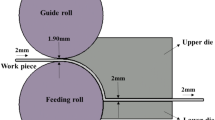Abstract
Ultrafine grained materials produced by severe plastic deformation methods possess attractive mechanical properties such as high strength compared with traditional coarse grained counterparts and reasonable ductility. Between existing severe plastic deformation methods the Equal Channel Angular Pressing is the most promising for future industrial applications and can produce a variety of ultrafine grained microstructures in materials depending on route, temperature and number of passes during processing. Driven by a rising trend of miniaturisation of parts these materials are promising candidates for microforming processes. Considering that bi-axial deformation of sheet (foil) is the major operation in microforming, the investigation of the influence of the number of ECAP passes on the bi-axial ductility in micro deep drawing test has been examined by experiments and FE simulation in this study. The experiments have showed that high force was required for drawing of the samples processed by ECAP compare to coarse grained materials. The limit drawing ratio of ultrafine grained samples was in the range of 1.9–2.0 with ECAP pass number changing from 1 to 16, while a higher value of 2.2 was obtained for coarse grained copper. However, the notable decrease in tensile ductility with increase in strength was not as pronounced for bi-axial ductility. The FE simulation using standard isotropic hardening model and von Mises yielding criterion confirmed these findings.










Similar content being viewed by others
References
Geiger M, Kleiner M, Eckstein R et al (2001) Manuf Technol 50:445
Geiger M, Meßner A, Engel U (1997) Prod Eng 41:55
Valiev RZ, Langdon TG (2006) Rev Adv Mater Sci 13(1):15
Miyazaki S, Shibata K, Fujita H (1979) Acta Mater 27:855
Michel JF, Picart P (2003) J Mater Process Technol 141:439
Raulea LV, Goijaerts AM, Govaert LE et al (2001) J Mater Process Technol 115:44
Kals TA, Eckstein R (2000) J Mater Process Technol 103:95
Lapovok R, McKenzie PWJ, Thomson PF et al (2007) J Mater Sci 42(5):1649. doi:https://doi.org/10.1007/s10853-006-0967-x
Lapovok R, Timokhina I, McKenzie PWJ et al (2008) J Mater Process Technol 200(1–3):441
Dalla Torre F, Lapovok R, Sandlin J et al (2004) Acta Mater 52(16):4819
Marciniak Z, Duncan JL, Hu SJ (2002) Mechanics of sheet metal forming. Butterworth-Heinemann, Oxford
Conrad H, Narayan J (2000) Scr Mater 42:1025
Acknowledgement
The project was supported by ARC Discovery grant DP0557255.
Author information
Authors and Affiliations
Corresponding author
Rights and permissions
About this article
Cite this article
Ma, X., Lapovok, R., Gu, C. et al. Deep drawing behaviour of ultrafine grained copper: modelling and experiment. J Mater Sci 44, 3807–3812 (2009). https://doi.org/10.1007/s10853-009-3515-7
Received:
Accepted:
Published:
Issue Date:
DOI: https://doi.org/10.1007/s10853-009-3515-7




